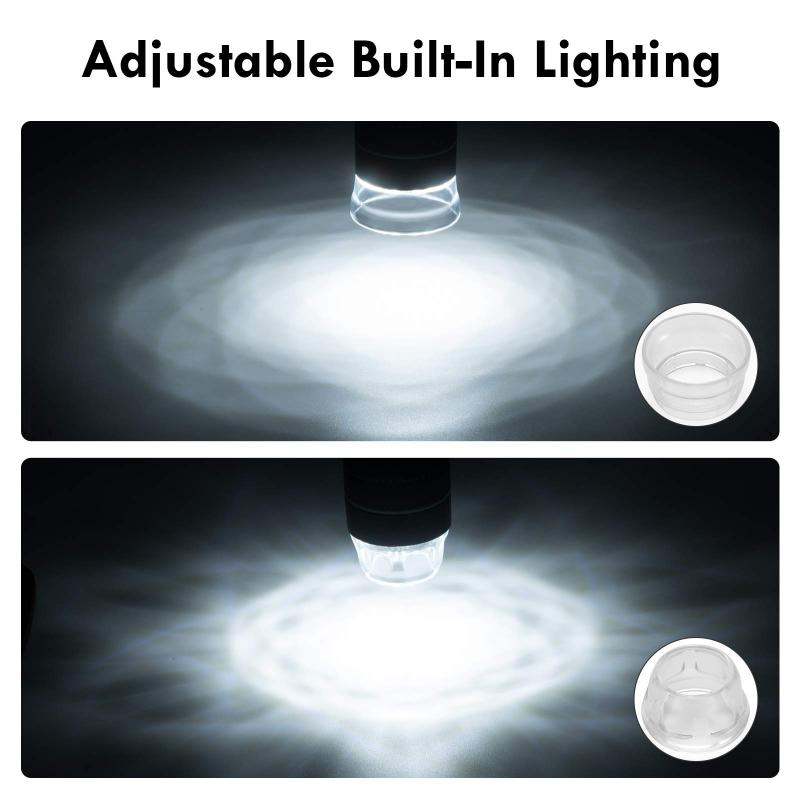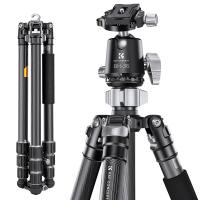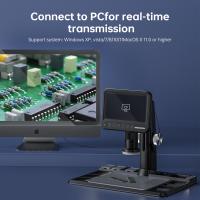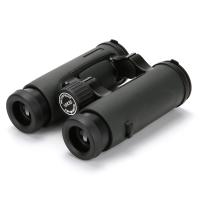What Is Afm Microscope ?
An atomic force microscope (AFM) is a type of microscope that uses a tiny probe to scan the surface of a sample to create a high-resolution, three-dimensional image. The probe is typically a sharp tip attached to a cantilever, which is moved across the surface of the sample by a piezoelectric scanner. As the tip moves over the surface, it interacts with the atoms and molecules on the surface, and the deflection of the cantilever is measured to create an image of the surface topography. AFMs are capable of imaging surfaces with atomic resolution, making them a valuable tool for studying the properties of materials at the nanoscale. They are used in a wide range of fields, including materials science, biology, and physics, and have applications in areas such as nanotechnology, surface science, and biophysics.
1、 Atomic force microscopy principles
Atomic force microscopy (AFM) is a type of scanning probe microscopy that allows for high-resolution imaging of surfaces at the atomic scale. It works by using a tiny probe, typically a few nanometers in size, to scan the surface of a sample and measure the forces between the probe and the surface. These forces are then used to create a three-dimensional image of the surface.
The principles of AFM are based on the interaction between the probe and the sample surface. As the probe scans the surface, it experiences various forces, including van der Waals forces, electrostatic forces, and chemical bonding forces. By measuring these forces, AFM can create a highly detailed image of the surface topography.
One of the key advantages of AFM is its ability to image samples in a variety of environments, including air, liquids, and even vacuum. This makes it a valuable tool for studying biological samples, as well as materials science and nanotechnology.
Recent advances in AFM technology have led to the development of new techniques, such as high-speed AFM and AFM-based nanomanipulation. These techniques allow for even higher resolution imaging and manipulation of samples at the atomic scale.
In summary, AFM is a powerful tool for imaging and manipulating surfaces at the atomic scale. Its principles are based on the interaction between the probe and the sample surface, and recent advances in technology have led to even higher resolution imaging and manipulation capabilities.

2、 AFM imaging modes
What is AFM microscope?
AFM stands for Atomic Force Microscope, which is a type of scanning probe microscope that is used to obtain high-resolution images of surfaces at the atomic level. The AFM microscope works by scanning a sharp tip over the surface of a sample, measuring the forces between the tip and the surface, and using this information to create a three-dimensional image of the surface.
The AFM microscope has become an essential tool in many fields of science and engineering, including materials science, nanotechnology, and biology. It allows researchers to study the properties of materials and biological samples at the nanoscale, providing insights into their structure, composition, and behavior.
AFM Imaging Modes:
There are several different imaging modes that can be used with an AFM microscope, each of which has its own advantages and limitations. Some of the most common AFM imaging modes include:
1. Contact Mode: In this mode, the tip is in constant contact with the surface of the sample, and the forces between the tip and the surface are used to create an image.
2. Tapping Mode: In this mode, the tip oscillates at a frequency near its resonance frequency, lightly tapping the surface of the sample. The forces between the tip and the surface are used to create an image.
3. Non-Contact Mode: In this mode, the tip is held at a distance from the surface of the sample, and the forces between the tip and the surface are measured. This mode is useful for imaging delicate samples that could be damaged by contact with the tip.
4. Dynamic Mode: In this mode, the tip is oscillated at a frequency near its resonance frequency, and the amplitude of the oscillation is used to create an image. This mode is useful for imaging samples with a high degree of topographical variation.
The latest point of view on AFM microscopy is that it has become an increasingly important tool for studying the properties of materials and biological samples at the nanoscale. Advances in AFM technology have made it possible to obtain high-resolution images of samples with unprecedented detail, allowing researchers to gain new insights into the structure and behavior of materials and biological systems. As such, AFM microscopy is likely to continue to play a critical role in many areas of science and engineering in the years to come.

3、 AFM sample preparation techniques
What is AFM microscope?
AFM stands for Atomic Force Microscope, which is a type of high-resolution scanning probe microscope used to obtain images of surfaces at the atomic level. It works by scanning a sharp tip over the surface of a sample, measuring the forces between the tip and the surface, and using this information to create a three-dimensional image of the surface.
AFM sample preparation techniques:
AFM sample preparation techniques are critical for obtaining high-quality images and accurate measurements. Some of the most common techniques include:
1. Cleaning: Before imaging, samples must be thoroughly cleaned to remove any contaminants or debris that could interfere with the measurement. This can be done using solvents, plasma cleaning, or other methods.
2. Mounting: Samples must be mounted securely to a substrate to prevent movement during imaging. This can be done using adhesives, clamps, or other methods.
3. Surface modification: In some cases, it may be necessary to modify the surface of the sample to improve imaging or measurement. This can be done using chemical treatments, ion beam etching, or other methods.
4. Tip preparation: The sharp tip used in AFM must be carefully prepared to ensure it is clean and sharp. This can be done using electrochemical etching, ion beam milling, or other methods.
The latest point of view:
Recent advances in AFM technology have led to the development of new sample preparation techniques, such as cryogenic AFM and in situ AFM. Cryogenic AFM allows imaging of samples at low temperatures, while in situ AFM allows imaging of samples under controlled environmental conditions. These techniques are particularly useful for studying biological samples and other complex systems. Additionally, advances in tip fabrication and functionalization have led to improved imaging resolution and the ability to measure a wider range of properties, such as electrical conductivity and magnetic fields.

4、 AFM data analysis methods
What is AFM microscope?
AFM stands for Atomic Force Microscope, which is a type of high-resolution scanning probe microscope used to obtain images of surfaces at the atomic level. It works by scanning a sharp tip over the surface of a sample, measuring the forces between the tip and the surface, and using this information to create a three-dimensional image of the surface.
AFM is widely used in materials science, nanotechnology, and biology to study the properties of surfaces and materials at the nanoscale. It can be used to measure surface roughness, topography, and mechanical properties such as stiffness and adhesion.
AFM data analysis methods:
AFM data analysis methods are used to extract useful information from the raw data obtained from AFM measurements. There are several different methods used for AFM data analysis, including image processing, statistical analysis, and modeling.
Image processing methods are used to enhance the quality of AFM images, remove noise, and improve contrast. This can be done using techniques such as filtering, thresholding, and edge detection.
Statistical analysis methods are used to extract quantitative information from AFM data, such as surface roughness, height distribution, and surface area. These methods include Fourier analysis, power spectral density analysis, and fractal analysis.
Modeling methods are used to simulate the behavior of materials and surfaces at the nanoscale, and to predict their properties based on their structure and composition. These methods include molecular dynamics simulations, finite element analysis, and continuum mechanics.
The latest point of view:
The latest developments in AFM data analysis methods are focused on improving the speed and accuracy of measurements, and on developing new techniques for studying complex materials and biological systems. For example, machine learning algorithms are being used to automate the analysis of AFM data, and to identify patterns and features that are difficult to detect using traditional methods. In addition, new imaging modes such as high-speed AFM and multi-frequency AFM are being developed to enable faster and more detailed imaging of surfaces and materials. Overall, AFM data analysis methods continue to evolve and improve, enabling researchers to gain new insights into the properties and behavior of materials at the nanoscale.







































